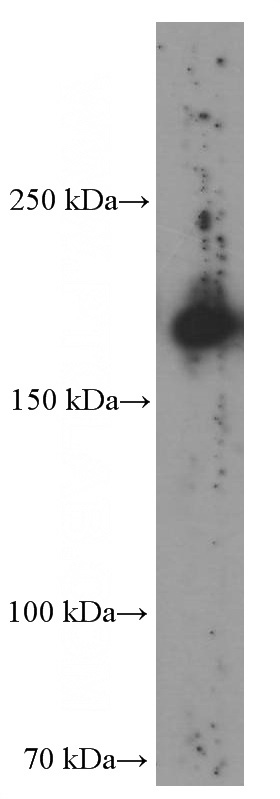-
Product Name
CD206 antibody
- Documents
-
Description
CD206 Mouse Monoclonal antibody. Positive WB detected in human liver tissue, human placenta tissue. Observed molecular weight by Western-blot: 170 kDa
-
Tested applications
ELISA, WB
-
Species reactivity
Human; other species not tested.
-
Alternative names
CD206 antibody; CLEC13D antibody; Macrophage mannose receptor 1 antibody; Mannose receptor antibody; mannose receptor antibody; C type 1 antibody; MMR antibody; MRC1 antibody
-
Isotype
Mouse IgG2a
-
Preparation
This antibody was obtained by immunization of Recombinant Protein (Accession Number: NM_002438). Purification method: Caprylic acid/ammonium sulfate precipitation.
-
Clonality
Monoclonal
-
Formulation
PBS with 0.1% sodium azide and 50% glycerol pH 7.3.
-
Storage instructions
Store at -20℃. DO NOT ALIQUOT
-
Applications
Recommended Dilution:
WB: 1:500-1:5000
-
Validations

human liver tissue were subjected to SDS PAGE followed by western blot with Catalog No:107052(MRC1 Antibody) at dilution of 1:1000
-
Background
CD206, also named as MMR, CLEC13D and MRC1, is a type I membrane receptor that mediates the endocytosis of glycoproteins by macrophages. CD206 has been shown to bind high-mannose structures on the surface of potentially pathogenic viruses, bacteria, and fungi so that they can be neutralized by phagocytic engulfment. CD206 is a 170 kDa transmembrane protein which contains 5 domains: an amino-terminal cysteine-rich region, a fibronectin type II repeat, a series of eight tandem lectin-like carbohydrate recognition domains (responsible for the recognition of mannose and fucose), a transmembrane domain, and an intracellular carboxy-terminal tail. It is expressed on most tissue macrophages, in vitro derived dendritic cells, lymphatic and sinusoidal endothelia. This antibody recognizes the intracellular carboxy-terminal part of CD206 and MRC1L1.
-
References
- Cui Z, Han D, Sun X. Mannose-modified chitosan microspheres enhance OprF-OprI-mediated protection of mice against Pseudomonas aeruginosa infection via induction of mucosal immunity. Applied microbiology and biotechnology. 99(2):667-80. 2015.
Related Products / Services
Please note: All products are "FOR RESEARCH USE ONLY AND ARE NOT INTENDED FOR DIAGNOSTIC OR THERAPEUTIC USE"
